Laboratory Evaluation of the Residue of Rubber-Modified Emulsified Asphalt
Abstract
:1. Introduction
2. Motivations and Objectives
3. Materials and Methods
3.1. Materials
3.2. Test Methods
4. Test Results and Analysis
4.1. The Comparison of Evaporation and Distillation Procedure
4.2. The Mass Change during the RTFO Test
4.3. DSR Test
4.3.1. The Master Curve of |G*| Based on the DSR Test
4.3.2. The Rutting Parameter (|G*|/sinδ) and the Fatigue Parameter (|G*|·sinδ)
4.4. ABCD Test
4.5. Fourier Transform Infrared (FTIR) Test
5. Conclusions
- The evaporation method was less effective than the distillation method in removing water from residue.
- The mass change during the RTFO process only represented the component change of emulsified asphalt binder residue.
- The high-temperature property of the CSS-1H was the best, and the high-temperature properties of the two emulsified asphalts with rubber were the worst. The original asphalt binder used to produce emulsified asphalt had a remarkable influence on the characteristics of emulsified asphalt.
- Polymer modification could enhance the low-temperature property of the emulsified asphalt. The low-temperature properties of CRS-2M and CRS-2TR residue were improved. The rubber modification enhanced the low-temperature characteristics of the emulsified asphalt binder, and the improvement effect enhanced as the rubber content increased.
- The C=O band was more sensitive to the aging condition of the residue than S=O, which can be used as an index to quantify the aging condition of the residue.
Author Contributions
Funding
Acknowledgments
Conflicts of Interest
References
- Marasteanu, M.O.; Clyne, T.R. Rheological characterization of asphalt emulsions residues. J. Mater. Civ. Eng. 2006, 18, 398–407. [Google Scholar] [CrossRef]
- Pang, J.Y.; Du, S.J.; Chang, R.T.; Pei, Q.; Cui, D.X. Effect of emulsifier content on the rheological properties of asphalt emulsion residues. J. Appl. Polym. Sci. 2015, 132, 7. [Google Scholar] [CrossRef]
- Takamura, K. Characterization of emulsion based warm mix binder. Road Mater. Pavement Des. 2008, 9, 87–102. [Google Scholar] [CrossRef]
- Yuliestyan, A.; Garcia-Morales, M.; Moreno, E.; Carrera, V.; Partal, P. Assessment of modified lignin cationic emulsifier for bitumen emulsions used in road paving. Mater. Des. 2017, 131, 242–251. [Google Scholar] [CrossRef]
- Ilias, M.; Adams, J.; Castorena, C.; Kim, Y.R. Performance-related specifications for asphalt emulsions used in microsurfacing treatments. Transp. Res. Record 2017, 2632, 1–13. [Google Scholar] [CrossRef]
- Hanz, A.J.; Johannes, P.; Bahia, H.U. Development of emulsion residue testing framework for improved chip seal performance. Transp. Res. Rec. J. Transp. Res. Board 2012, 2293, 106–113. [Google Scholar] [CrossRef]
- Khadivar, A.; Kavussi, A. Rheological characteristics of SBR and NR polymer modified bitumen emulsions at average pavement temperatures. Constr. Build. Mater. 2013, 47, 1099–1105. [Google Scholar] [CrossRef]
- Abedini, M.; Hassani, A.; Kaymanesh, M.R.; Yousefi, A.A. The rheological properties of a bitumen emulsion modified with two types of SBR latex. Pet. Sci. Technol. 2016, 34, 1589–1594. [Google Scholar] [CrossRef]
- Abedini, M.; Hassani, A.; Kaymanesh, M.R.; Yousefi, A.A.; Abedini, H. Multiple stress creep and recovery behavior of SBR-modified bitumen emulsions. J. Test. Eval. 2020, 48. [Google Scholar] [CrossRef]
- Ferdous, W.; Manalo, A.; Wong, H.S.; Abousnina, R.; AlAjarmeh, O.S.; Zhuge, Y.; Schubel, P. Optimal design for epoxy polymer concrete based on mechanical properties and durability aspects. Constr. Build. Mater. 2020, 232, 117229. [Google Scholar] [CrossRef]
- Sarkar, M.T.A.; Rahman, M.N.; Elseifi, M.A.; Mayeux, C.; Cooper, S.B., III. Rheological and molecular characterizations of tire rubber modified asphalt emulsion. Transp. Res. Record 2020. [Google Scholar] [CrossRef]
- Forbes, A.; Haverkamp, R.G.; Robertson, T.; Bryant, J.; Bearsley, S. Studies of the microstructure of polymer-modified bitumen emulsions using confocal laser scanning microscopy. J. Microsc. 2001, 204, 252–257. [Google Scholar] [CrossRef] [PubMed] [Green Version]
- Cuadri, A.; Roman, C.; Garcia-Morales, M.; Guisado, F.; Moreno, E.; Partal, P. Formulation and processing of recycled-low-density-polyethylene-modified bitumen emulsions for reduced-temperature asphalt technologies. Chem. Eng. Sci. 2016, 156, 197–205. [Google Scholar] [CrossRef]
- Chen, X.; Wang, H.N.; Wang, Q.H.; Yang, X.; You, Z.P. Optimization of laboratory preparation of the emulsified bioasphalt with two emulsifiers. J. Test. Eval. 2018, 46, 1343–1354. [Google Scholar] [CrossRef]
- Sheng, X.; Wang, M.; Xu, T.; Chen, J. Preparation, properties and modification mechanism of polyurethane modified emulsified asphalt. Constr. Build. Mater. 2018, 189, 375–383. [Google Scholar] [CrossRef]
- Taha, R.; Hassan, H.; Al-Rawas, A.; Yaghi, B.; Al-Futaisi, A.; Jamrah, A.; Al-Suleimani, Y. Use of tank bottom sludge to construct and upgrade unpaved roads. Transp. Res. Record 2007, 208–214. [Google Scholar] [CrossRef]
- Carrera, V.; Cuadri, A.; García-Morales, M.; Partal, P. The development of polyurethane modified bitumen emulsions for cold mix applications. Mater. Struct. 2015, 48, 3407–3414. [Google Scholar] [CrossRef] [Green Version]
- Li, R.; Leng, Z.; Zhang, Y.; Ma, X. Preparation and characterization of waterborne epoxy modified bitumen emulsion as a potential high-performance cold binder. J. Clean. Prod. 2019, 235, 1265–1275. [Google Scholar] [CrossRef]
- Gutiérrez Klinsky, L.M.; Motta, R.; Bariani Bernucci, L.L. Cold recycled asphalt mixture using 100% RAP with emulsified asphalt-recycling agent as a new pavement base course. Adv. Mater. Sci. Eng. 2020, 2020. [Google Scholar] [CrossRef] [Green Version]
- Yang, X.; You, Z.; Perram, D.; Hand, D.; Ahmed, Z.; Wei, W.; Luo, S. Emission analysis of recycled tire rubber modified asphalt in hot and warm mix conditions. J. Hazard. Mater. 2019, 365, 942–951. [Google Scholar] [CrossRef]
- Ling, C.; Moraes, R.; Swiertz, D.; Bahia, H. Measuring the influence of aggregate coating on the workability and moisture susceptibility of cold-mix asphalt. Transp. Res. Record 2013, 2372, 46–52. [Google Scholar] [CrossRef]
- Abd El-Rahman, A.M.M.; El-Shafie, M.; Abo-Shanab, Z.L.; El-Kholy, S.A. Modifying asphalt emulsion with different types of polymers for surface treatment applications. Pet. Sci. Technol. 2017, 35, 1473–1480. [Google Scholar] [CrossRef]
- Ma, T.; Wang, H.; Zhao, Y.; Huang, X. Laboratory investigation on residual strength of reclaimed asphalt mixture for cold mix recycling. Int. J. Pavement Res. Technol. 2015, 8. [Google Scholar] [CrossRef]
- Cardone, F.; Virgili, A.; Graziani, A. Evaluation of bonding between reclaimed asphalt aggregate and bitumen emulsion composites. Constr. Build. Mater. 2018, 184, 565–574. [Google Scholar] [CrossRef]
- Li, Y.; Lyv, Y.; Fan, L.; Zhang, Y. Effects of cement and emulsified asphalt on properties of mastics and 100% cold recycled asphalt mixtures. Materials 2019, 12, 754. [Google Scholar] [CrossRef] [PubMed] [Green Version]
- Du, S. Interaction mechanism of cement and asphalt emulsion in asphalt emulsion mixtures. Mater. Struct. 2014, 47, 1149–1159. [Google Scholar] [CrossRef]
- Chavez-Valencia, L.; Alonso, E.; Manzano, A.; Perez, J.; Contreras, M.; Signoret, C. Improving the compressive strengths of cold-mix asphalt using asphalt emulsion modified by polyvinyl acetate. Constr. Build. Mater. 2007, 21, 583–589. [Google Scholar] [CrossRef]
- Jiang, J.; Ni, F.; Zheng, J.; Han, Y.; Zhao, X. Improving the high-temperature performance of cold recycled mixtures by polymer-modified asphalt emulsion. Int. J. Pavement Eng. 2020, 21, 41–48. [Google Scholar] [CrossRef]
- Hoyt, D.; Martin, A.E.; Shuler, S. Surface performance-grading system to grade chip seal emulsion residues. Transp. Res. Rec. J. Transp. Res. Board 2010, 2150, 63–69. [Google Scholar] [CrossRef]
- ASTM. Standard practice for recovering residue from emulsified asphalt using low temperature evaporative technique. In ASTM D7497; ASTM International: West Conshohocken, PA, USA, 2016. [Google Scholar]
- Malladi, H.; Asnake, M.; LaCroix, A.; Castorena, C. Low-temperature vacuum drying procedure for rapid asphalt emulsion residue recovery. Transp. Res. Record 2018, 2672, 256–265. [Google Scholar] [CrossRef]
- Farrar, M.J.; Salmans, S.L.; Planche, J.P. Recovery and laboratory testing of asphalt emulsion residue application of simple aging test and 4-mm dynamic shear rheometer test. Transp. Res. Record 2013, 69–75. [Google Scholar] [CrossRef]
- Boysen, R.B.; Farrar, M.J.; Planche, J.-P. Quantification of water in asphalt by Karl Fischer titration and its application to emulsion recovery. Transp. Res. Record 2014, 2444, 97–101. [Google Scholar] [CrossRef]
- ASTM. Standard test method for residue by evaporation of emulsified asphalt. In ASTM D6934; ASTM International: West Conshohocken, PA, USA, 2016. [Google Scholar]
- ASTM. Standard test method for distillation of emulsified asphalt. In ASTM D6997; ASTM International: West Conshohocken, PA, USA, 2012. [Google Scholar]
- Prapaitrakul, N.; Han, R.; Jin, X.; Martin, A.E.; Glover, C.J. Comparative study on recovered binder properties using three asphalt emulsion recovery methods. J. Test. Eval. 2010, 38, 653–659. [Google Scholar]
- Salomon, D.; Thompson, M.; Dur, G.; Gueit, C.; Deneuvillers, C.; Robert, M.; Lebon, A.; Sa, C. Comparison of rheological properties for recovered residue from emulsified asphalt obtained by three recovery procedures. In Proceedings of the 2008 International Symposium of Asphalt Emulsion Technology (ISAET), Washington, DC, USA, 26 September 2008. [Google Scholar]
- Sun, Y.; Yue, J.-C.; Wang, R.-R.; Li, R.-X.; Wang, D.-C. Investigation of the effects of evaporation methods on the high-temperature rheological and fatigue performances of emulsified asphalt residues. Adv. Mater. Sci. Eng. 2020, 2020. [Google Scholar] [CrossRef] [Green Version]
- Islam, R.M.; Ashani, S.S.; Wasiuddin, N.M. Effects of curing time, temperature, and vacuum pressure on asphalt emulsion residue recovered by vacuum drying method. J. Test. Eval. 2015, 43, 1134–1145. [Google Scholar] [CrossRef]
- ASTM. Standard test method for effect of heat and air on a moving film of asphalt (rolling thin-film oven test). In ASTM D2872; ASTM International: West Conshohocken, PA, USA, 2012. [Google Scholar]
- ASTM. Standard practice for accelerated aging of asphalt binder using a pressurized aging vessel (pav). In ASTM D6521; ASTM International: West Conshohocken, PA, USA, 2018. [Google Scholar]
- Ge, D.; Yan, K.; Ye, F.; Zhao, X. The laboratory performance of asphalt mixture with Amorphous poly alpha olefins (APAO) modified asphalt binder. Constr. Build. Mater. 2018, 188, 676–684. [Google Scholar] [CrossRef]
- Zhang, R.; You, Z.; Wang, H.; Ye, M.; Yap, Y.K.; Si, C. The impact of bio-oil as rejuvenator for aged asphalt binder. Constr. Build. Mater. 2019, 196, 134–143. [Google Scholar] [CrossRef]
- Yao, H.; Dai, Q.; You, Z.; Ye, M.; Yap, Y.K. Rheological properties, low-temperature cracking resistance, and optical performance of exfoliated graphite nanoplatelets modified asphalt binder. Constr. Build. Mater. 2016, 113, 988–996. [Google Scholar] [CrossRef]
- You, Z.; Mills-Beale, J.; Fini, E.; Goh, S.W.; Colbert, B. Evaluation of low-temperature binder properties of warm-mix asphalt, extracted and recovered RAP and RAS, and bioasphalt. J. Mater. Civ. Eng. 2011, 23, 1569–1574. [Google Scholar] [CrossRef]
- Kim, S.S. Development of an Asphalt Binder Cracking Device; IDEA Program, Transportation Research Board: Washington, DC, USA, 2007. [Google Scholar]
- Ge, D.; You, Z.; Chen, S.; You, L. Using DSR and FTIR to evaluate asphalt binder extracted and recovered from asphalt mixtures. In Proceedings of the Congress on Technical Advancement 2017, Duluth, MI, USA, 10–13 September 2017; pp. 89–105. [Google Scholar]
- Yao, H.; You, Z.; Li, L.; Lee, C.H.; Wingard, D.; Yap, Y.K.; Shi, X.; Goh, S.W. Rheological properties and chemical bonding of asphalt modified with nanosilica. J. Mater. Civ. Eng. 2013, 25, 1619–1630. [Google Scholar] [CrossRef] [Green Version]
- Khotbehsara, M.M.; Manalo, A.; Aravinthan, T.; Reddy, K.R.; Ferdous, W.; Wong, H.; Nazari, A. Effect of elevated in-service temperature on the mechanical properties and microstructure of particulate-filled epoxy polymers. Polym. Degrad. Stab. 2019, 170, 108994. [Google Scholar] [CrossRef]
- Yang, X.; You, Z.; Mills-Beale, J. Asphalt binders blended with a high percentage of biobinders: Aging mechanism using FTIR and rheology. J. Mater. Civ. Eng. 2015, 27, 04014157. [Google Scholar] [CrossRef]
- Ge, D.; Chen, S.; You, Z.; Yang, X.; Yao, H.; Ye, M.; Yap, Y.K. Correlation of DSR results and FTIR’s carbonyl and sulfoxide indexes: Effect of aging temperature on asphalt rheology. J. Mater. Civ. Eng. 2019, 31, 04019115. [Google Scholar] [CrossRef]
- Yang, X.; You, Z. New predictive equations for dynamic modulus and phase angle using a nonlinear least-squares regression model. J. Mater. Civ. Eng. 2014, 27, 04014131. [Google Scholar] [CrossRef]
- Ge, D.; You, Z.; Chen, S.; Liu, C.; Gao, J.; Lv, S. The performance of asphalt binder with trichloroethylene: Improving the efficiency of using reclaimed asphalt pavement. J. Clean. Prod. 2019, 232, 205–212. [Google Scholar] [CrossRef]
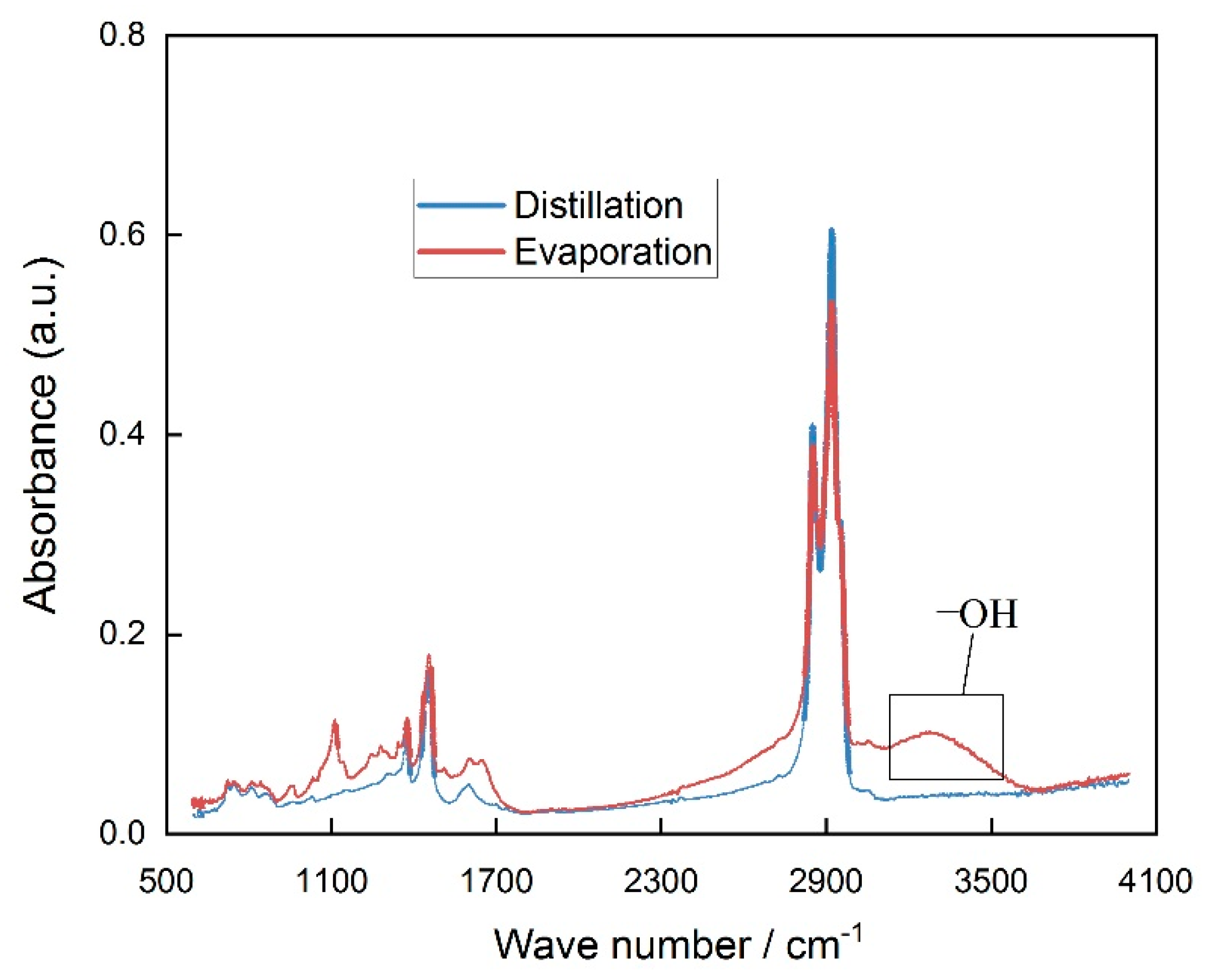
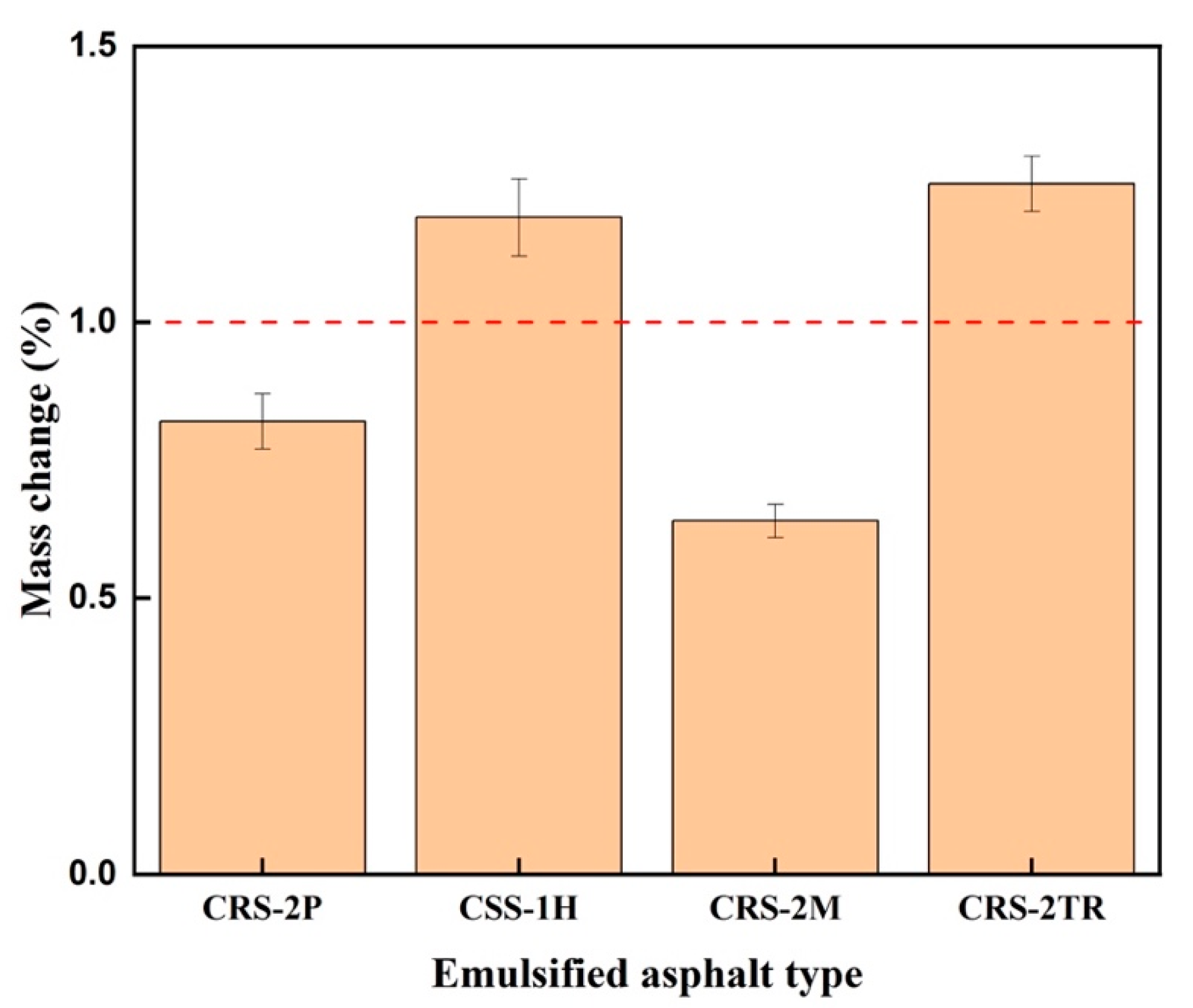
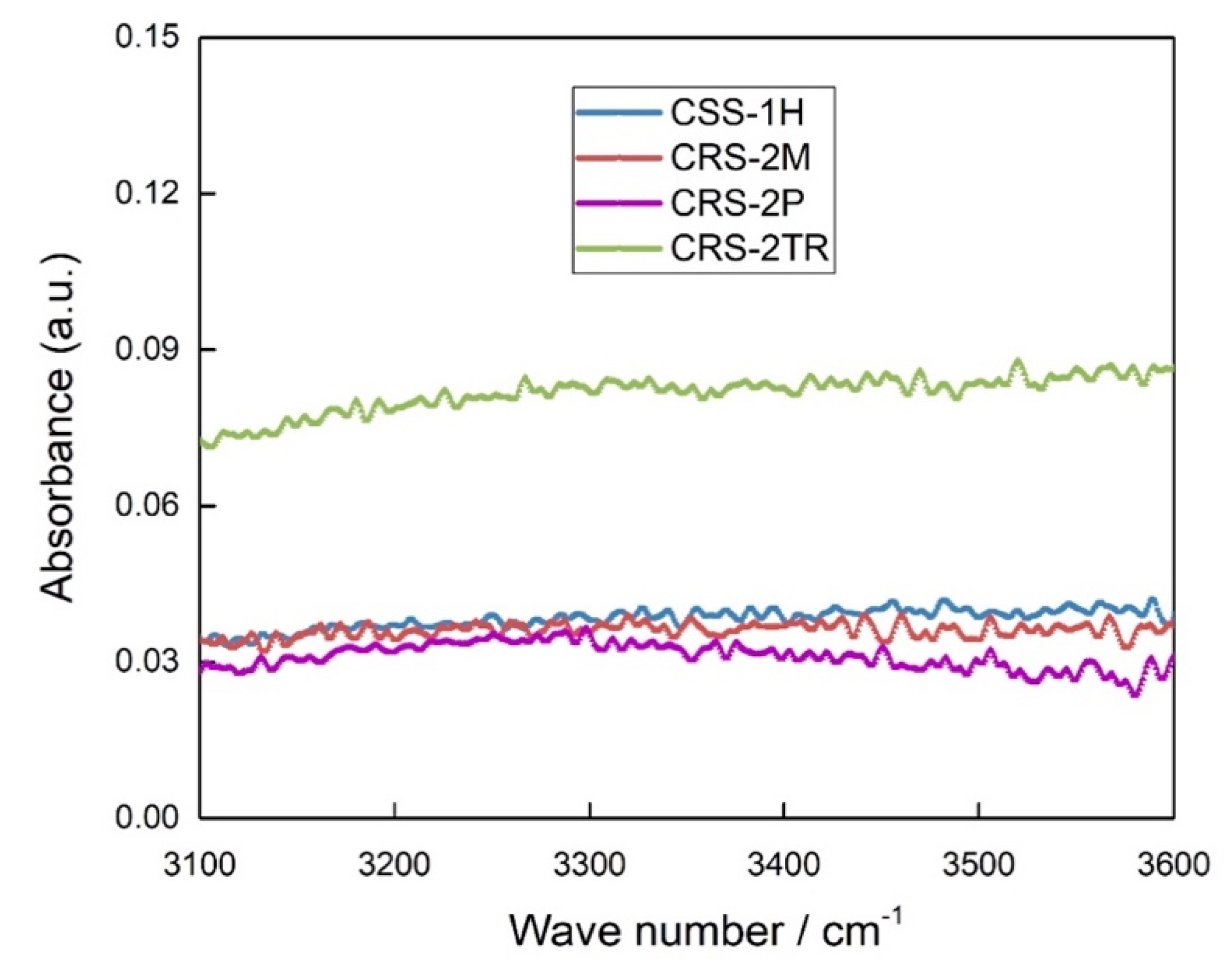
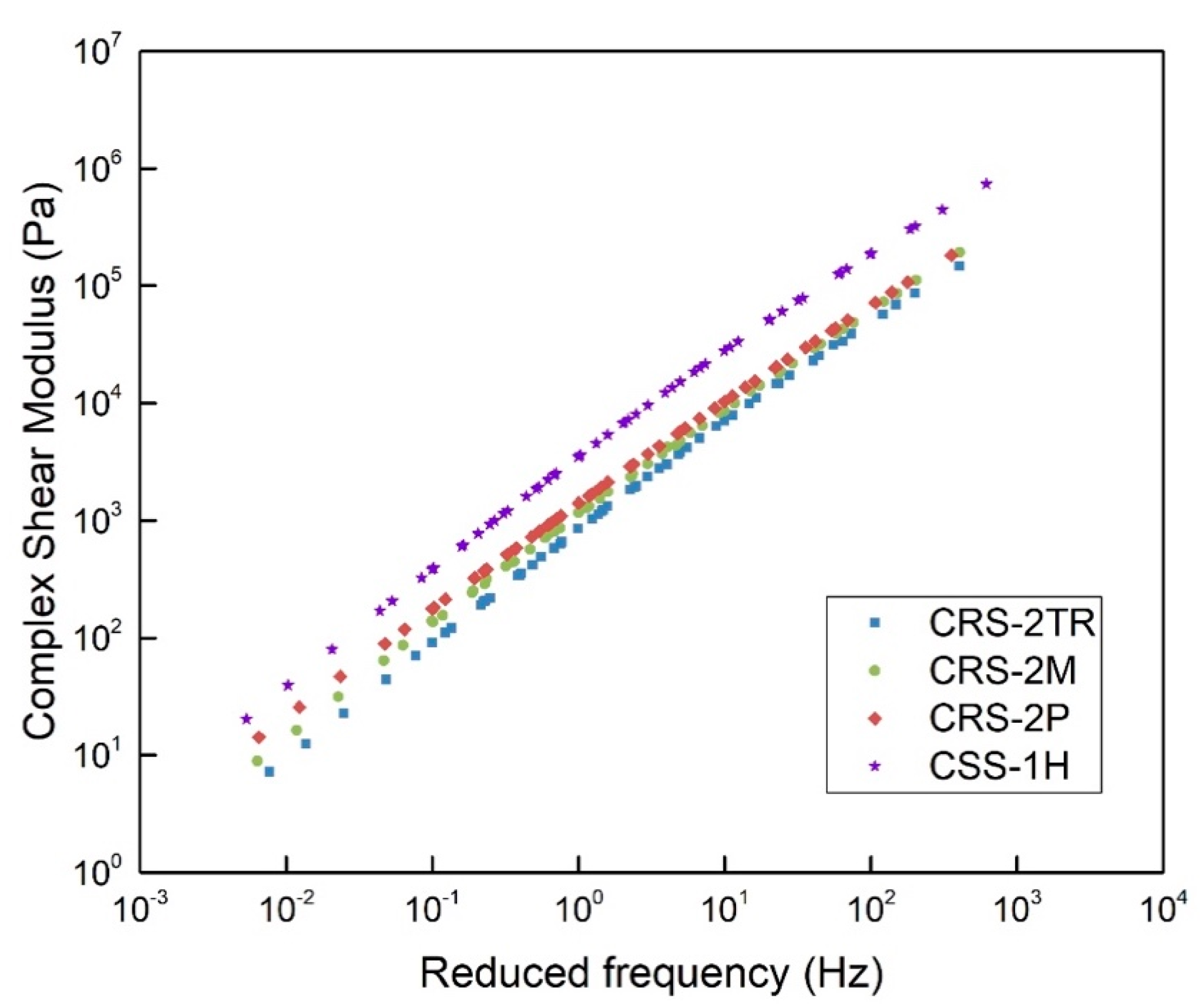
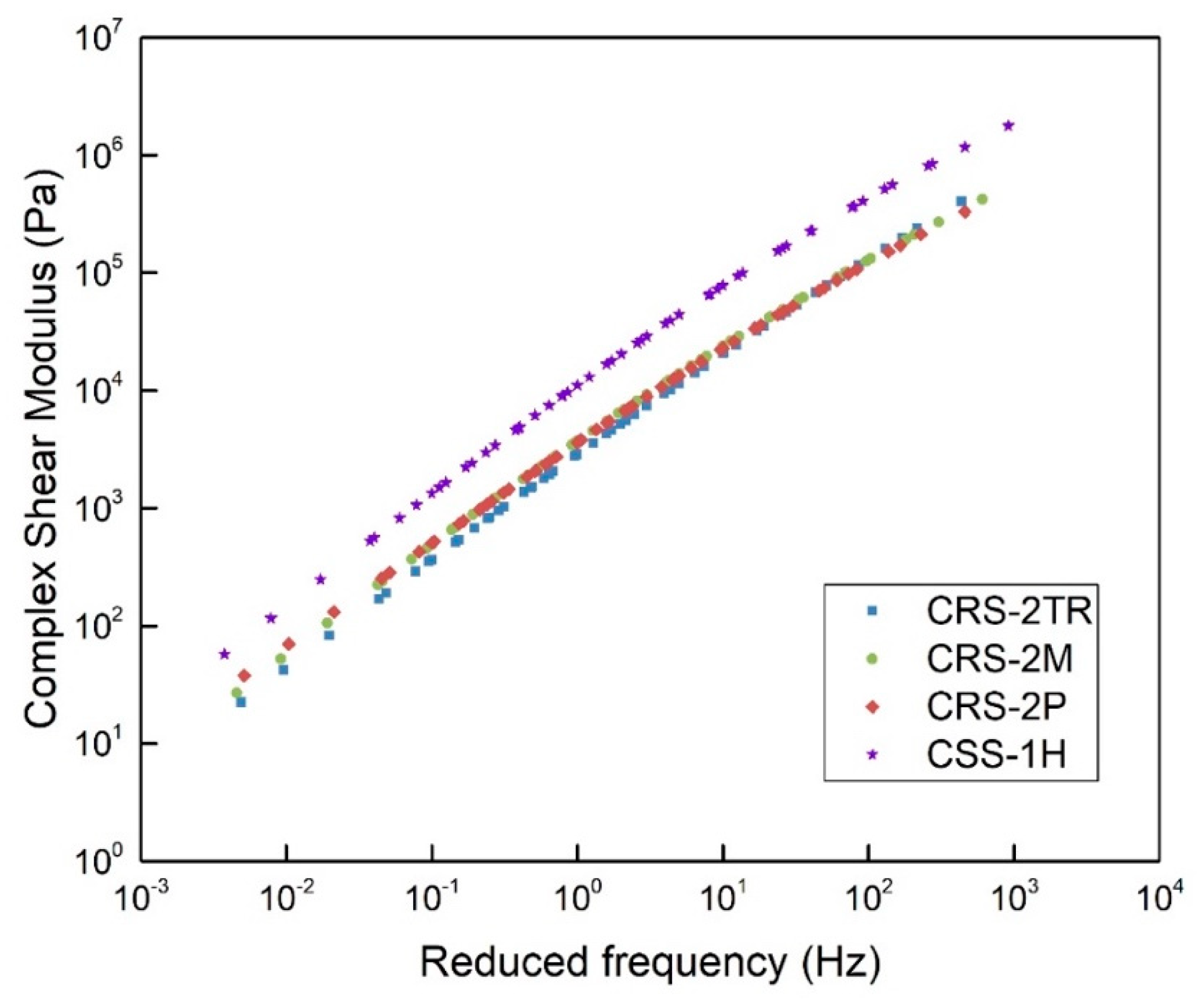
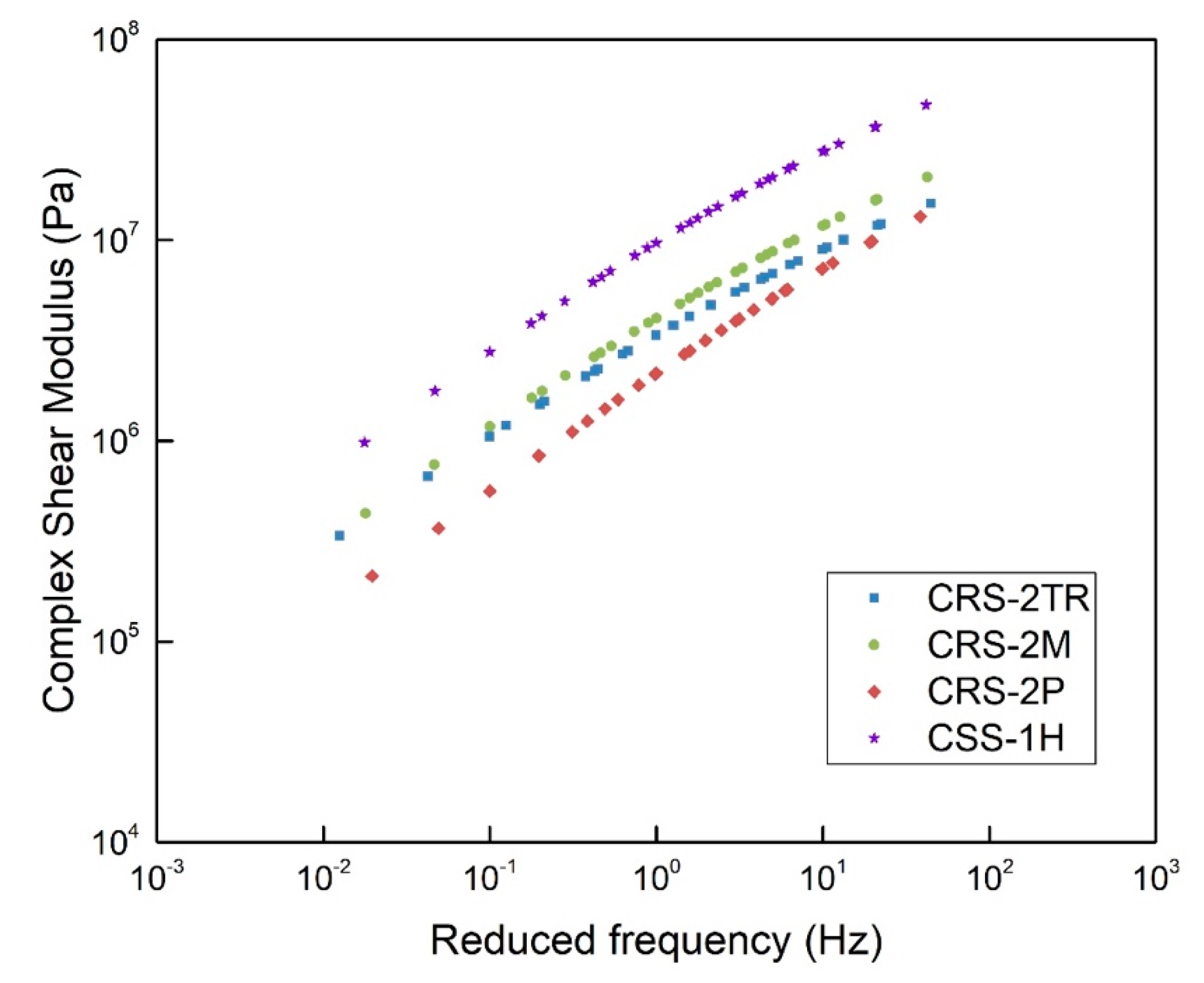

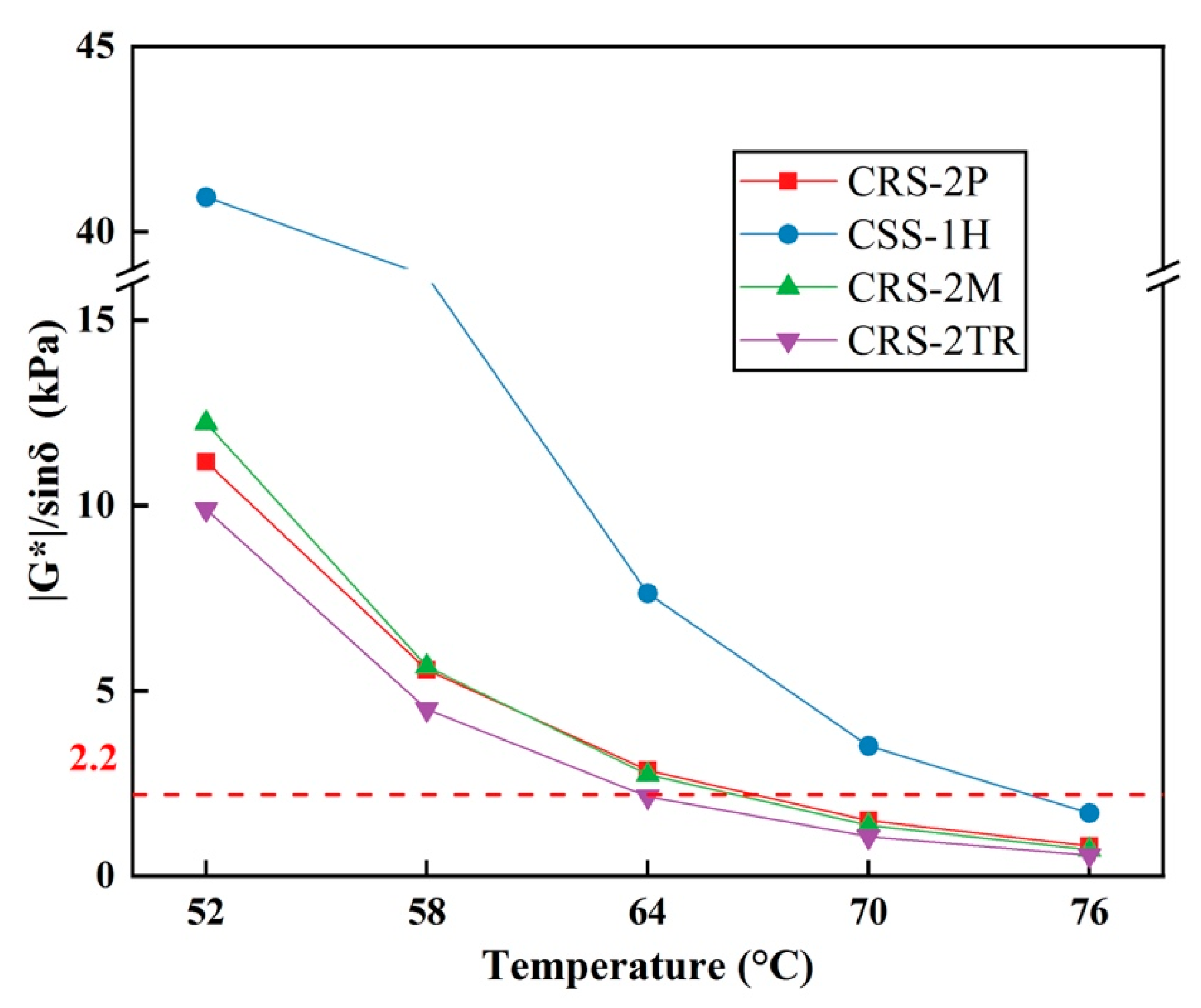

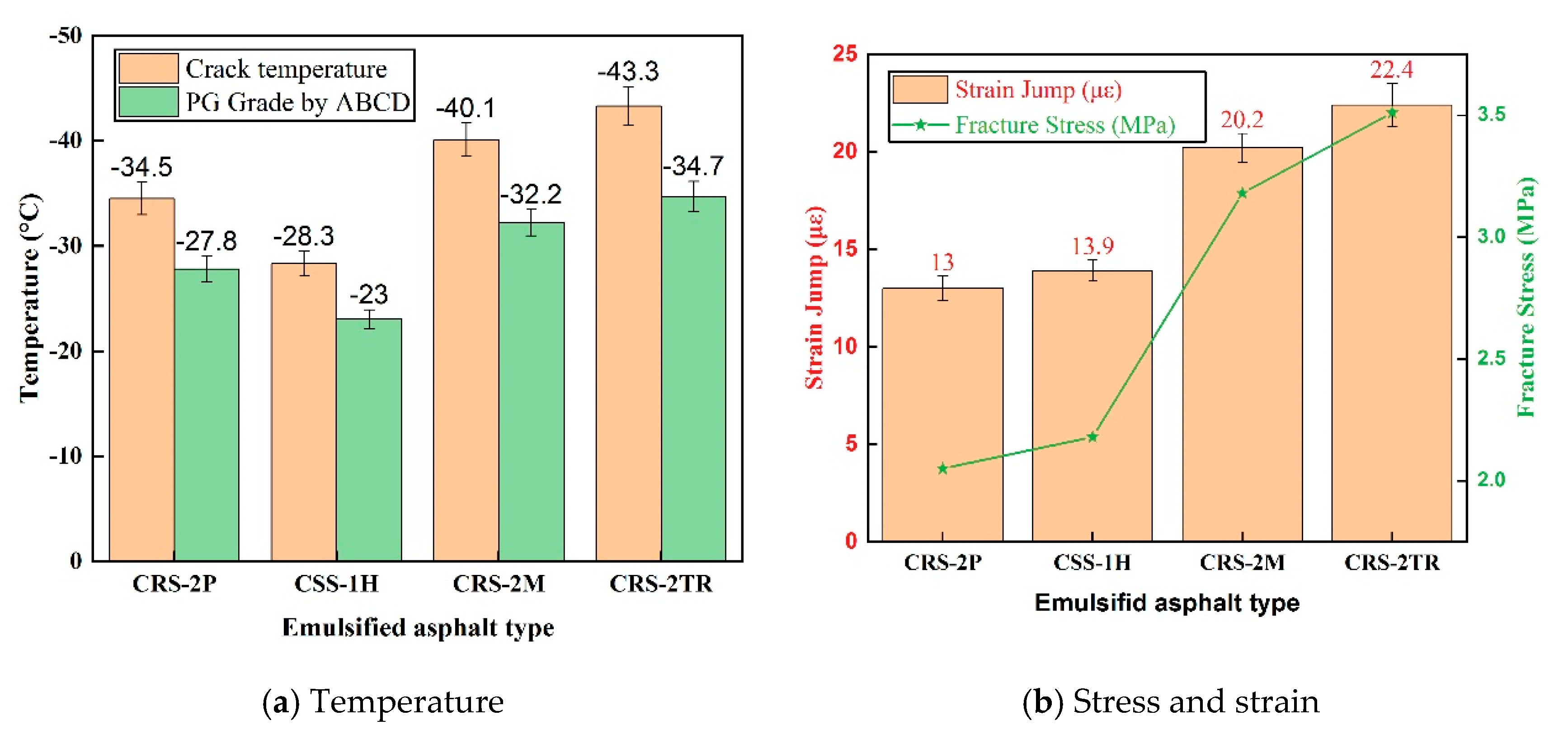

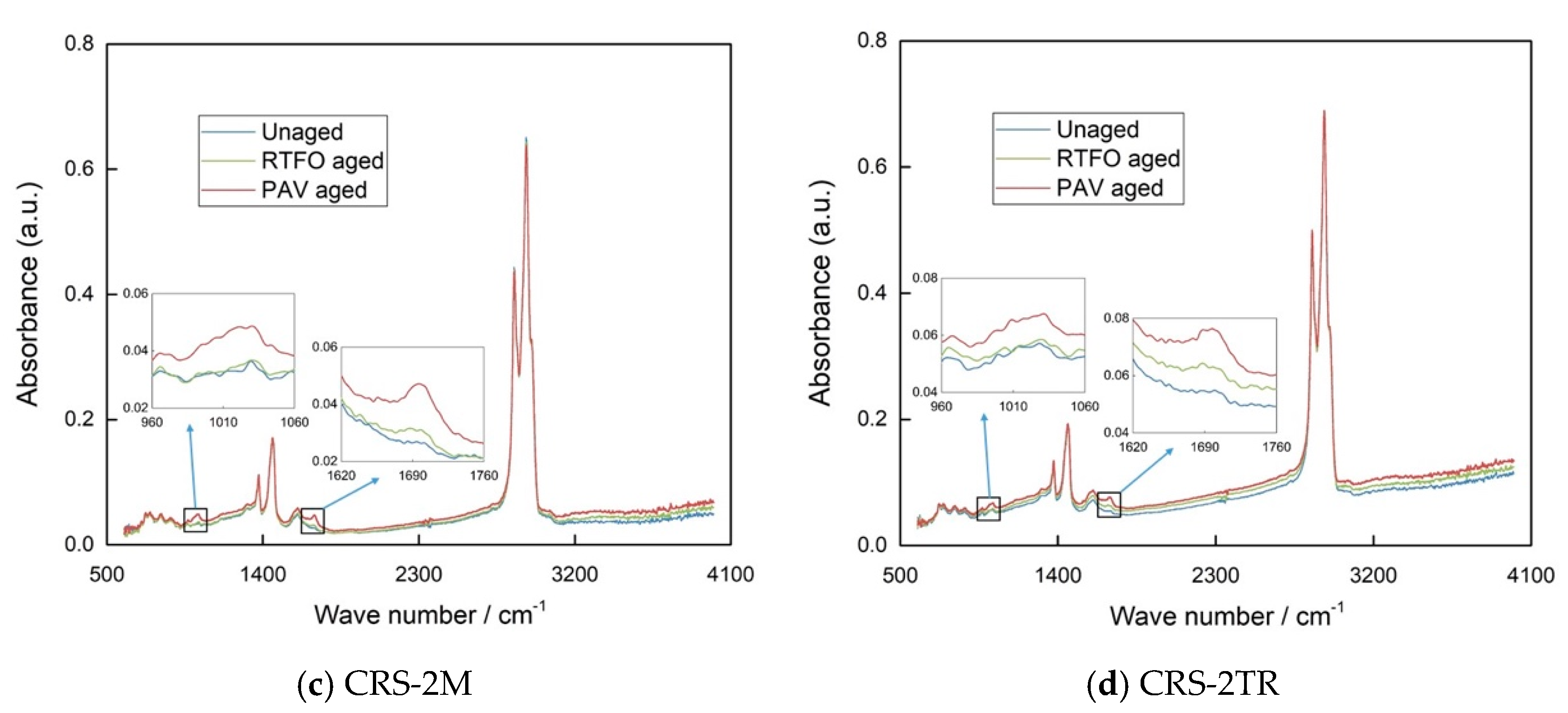
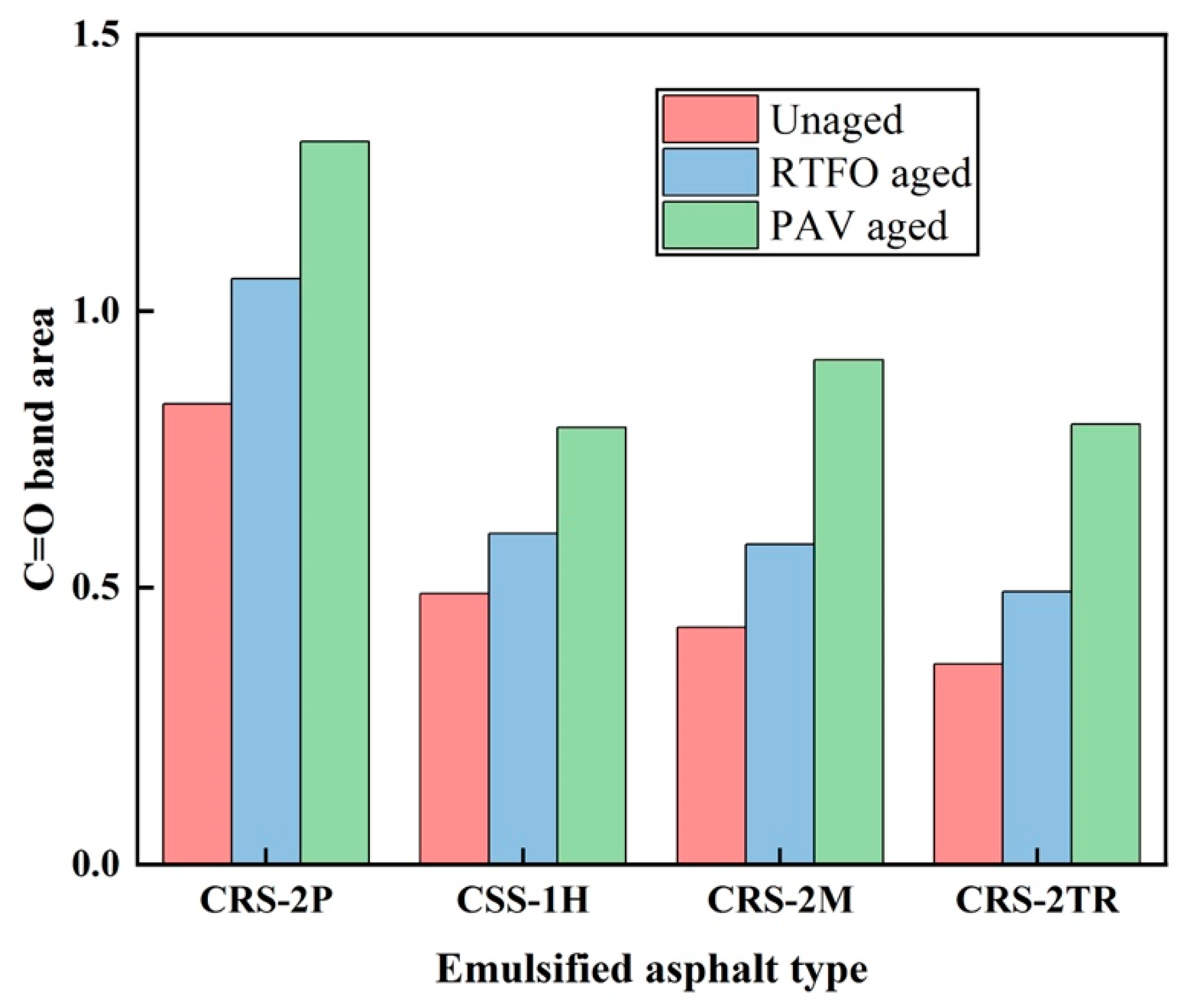
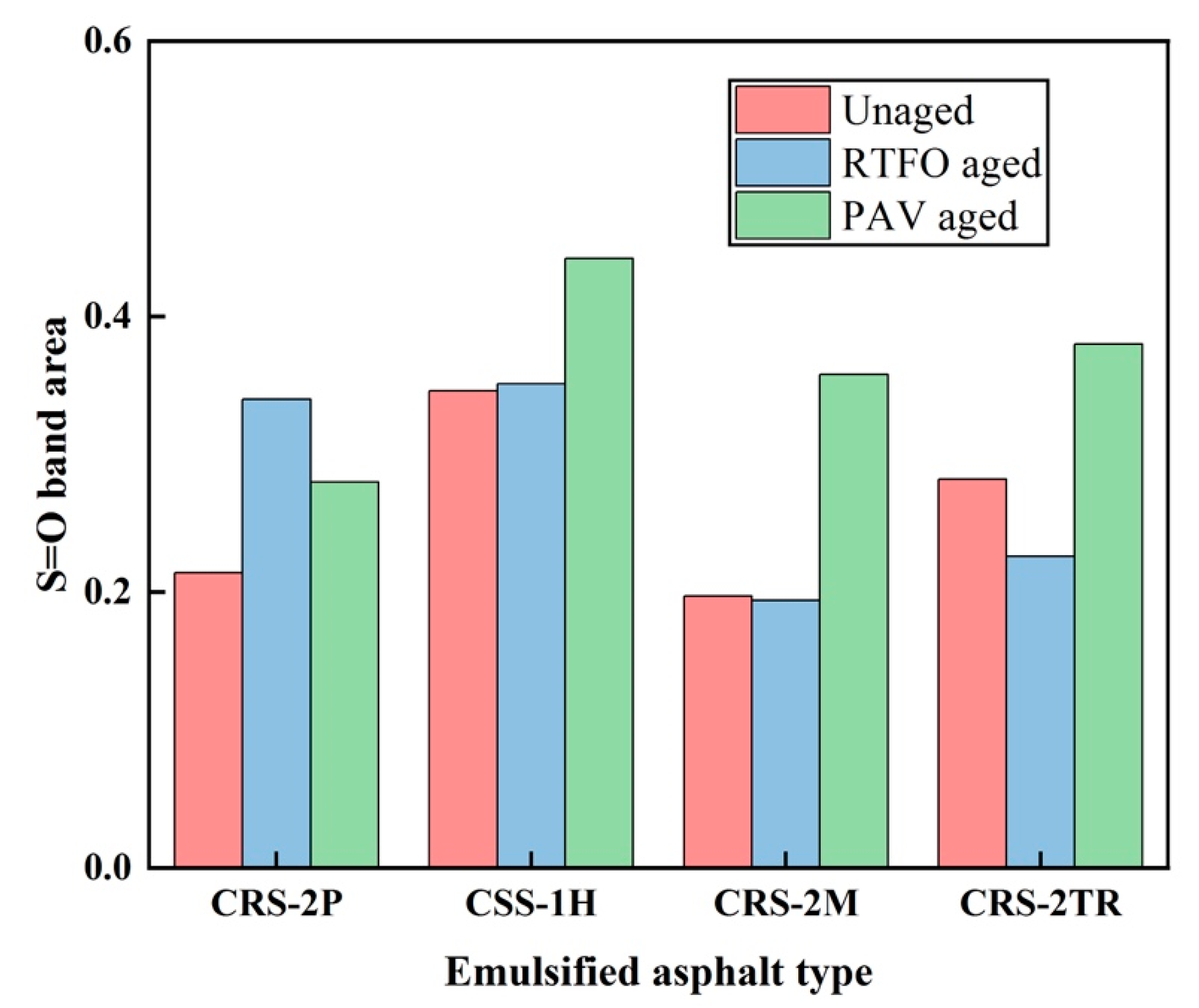
| Property | CRS-2P | CSS-1H | CRS-2M | CRS-2TR |
|---|---|---|---|---|
| Viscosity, SFS@50 °C, s | 76 | 84 | 200 | 498.5 |
| Residue by distillation, % | 69.6 | 63.5 | 68.0 | 65.5 |
| Demulsibility, % | 76.8 | - | 74.6 | 47.8 |
| Penetration, 100 g, 5 s, dmm, 25 °C | 106 | 53 | 110 | 116 |
| Ductility, 5 cm/min, cm, 25 °C | 350 | 106 | 70 | 65 |
| Sieve Test, %, wt | 0.78 | 0 | 0.05 | 0 |
| Materials | CRS-2P, CRS-2M, CSS-1H, and CRS-2TR | ||
|---|---|---|---|
| Test methods | DSR | Unaged and RTFO aged (34 to 82 °C, 6 °C increment) | Frequency (0.1, 1, 1.59, 3, 5, and 10 Hz) |
| PAV aged (13 to 25 °C, 3 °C increment) | |||
| ABCD | Test temperature (10 °C to −60 °C) | ||
| FTIR | Wavelength (600–4000 cm−1), resolution (4 cm−1) | ||
| Emulsified Asphalt Type | High-Temperature (°C) | Low-Temperature (°C) |
|---|---|---|
| DSR | ABCD | |
| CRS-2P | 64 | −27.8 |
| CSS-1H | 70 | −23.0 |
| CRS-2M | 58 | −32.2 |
| CRS-2TR | 58 | −34.7 |
© 2020 by the authors. Licensee MDPI, Basel, Switzerland. This article is an open access article distributed under the terms and conditions of the Creative Commons Attribution (CC BY) license (http://creativecommons.org/licenses/by/4.0/).
Share and Cite
Ge, D.; Zhou, X.; Chen, S.; Jin, D.; You, Z. Laboratory Evaluation of the Residue of Rubber-Modified Emulsified Asphalt. Sustainability 2020, 12, 8383. https://doi.org/10.3390/su12208383
Ge D, Zhou X, Chen S, Jin D, You Z. Laboratory Evaluation of the Residue of Rubber-Modified Emulsified Asphalt. Sustainability. 2020; 12(20):8383. https://doi.org/10.3390/su12208383
Chicago/Turabian StyleGe, Dongdong, Xiaodong Zhou, Siyu Chen, Dongzhao Jin, and Zhanping You. 2020. "Laboratory Evaluation of the Residue of Rubber-Modified Emulsified Asphalt" Sustainability 12, no. 20: 8383. https://doi.org/10.3390/su12208383
APA StyleGe, D., Zhou, X., Chen, S., Jin, D., & You, Z. (2020). Laboratory Evaluation of the Residue of Rubber-Modified Emulsified Asphalt. Sustainability, 12(20), 8383. https://doi.org/10.3390/su12208383








